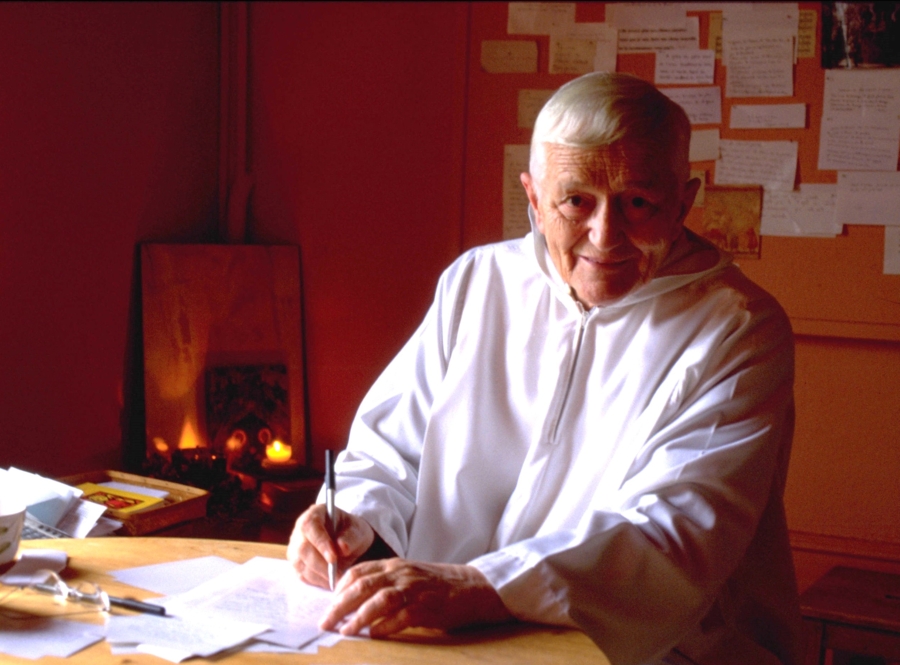Brother Roger

Biography
In 1939, as a theology student in Lausanne, Roger Schutz-Marsauche, the son of a Protestant pastor, brought together friends in a common search by organizing study groups and spiritual retreats. With two of them he formed a confraternity, the first expression of the community he envisioned.
A house was needed for these meetings. With the outbreak of World War II, in August 1940, at the age of 25, he decided to look for this house in France, a place then marked by human distress. He settled in the village of Taizé, close to the demarcation line that divided France in half. There he welcomed refugees, especially Jews. Alone, he already prayed three times a day in a small oratory.
When the whole of France was occupied, he was in Geneva and was forced to remain there. It was there that he met his first brothers and began a life together. To show that the burgeoning community was part of the church, he was ordained a pastor. As soon as France was liberated, in autumn 1944, the brothers returned to Taizé where they led a life of prayer, work, study and hospitality.
A few other young men gradually joined them, and at Easter 1949, seven of them made a lifelong commitment to celibacy, accepting the ministry of the prior and sharing material and spiritual goods.
Founder and prior, Brother Roger wrote the Rule of Taizé in 1951-1952. Like other founders in history, his deepest intention was to respond to the great questions of the day. By giving the community the vocation of being a parable of communion, he invited it to open up ways of healing the rifts between separated Christians and overcoming conflicts in humanity. For him the reconciliation of Christians was not an end in itself, but a prerequisite if they were to be promoters of trust between peoples, a leaven of peace.
The ecumenical vocation would be at the heart of Brother Roger's life. He established contacts with Christians of various denominations. He went to Rome to meet successive popes, from Pius XII to John Paul II, to England to forge links with the Anglican Church, and to Istanbul to visit the Orthodox Patriarch. His initiatives were not always understood, and sometimes exposed him to difficult moments either with French Protestant leaders or at the Vatican when, in 1974, he was summoned to Rome by the Congregation of the Doctrine of the Faith (formerly the Holy Office). But tensions soon subsided, and in his old age he was able to write: “I have found my Christian identity by reconciling the faith of my origins with the mystery of the Catholic faith, without breaking communion with anyone.”
He wanted the community to be present in its time, in solidarity with the poorest and those whose human rights were being trampled. As soon as there were twelve brothers, some of them were sent to live in small groups in deprived parts of the world, and he himself spent periods in places undergoing trials: Chile, Calcutta, South Africa, Lebanon, Haiti, the Sahel, Ethiopia, India, the Philippines…. During the period when Europe was divided into two blocs, he went every year to certain Eastern European countries, to be close to those who were trapped within their borders with no possibility of expressing themselves. “I will be silent with you”, he said to the Christians of these countries. He also visited heads of state to plead for peace. These efforts were recognized by several international awards.
In 1963 he launched Operation Hope, a fund-raising campaign initially meant to support agricultural cooperatives in Latin America, and then to help populations in difficulty in various parts of the world. It also financed the sending of a million New Testaments to Latin America and a million Bibles to the Russian Orthodox Church.
From 1957-58 on, more and more young people from Europe and other continents came to the community. Brother Roger opened the doors wide, and meetings were organized by the brothers on the topic of inner life and human solidarity. During days of prayer and sharing with other participants from many nations, these young people have attempted to discover meaning in their lives and find new energy. In this way several generations have acquired a sense of prayer, a universal vision of the Church, trust in other peoples, attention to human rights, international awareness and sensitivity to peace.
In 1970, Brother Roger announced that a Council of Youth would be held, to give young people an experience similar to that of the bishops at the Second Vatican Council. This was later replaced by a pilgrimage of trust on earth, which does not constitute a movement around the community but stimulates young people to be bearers of peace and reconciliation in the places where they live. The pilgrimage includes local, international and continental gatherings, notably an annual European meeting in a large Western or Eastern city, during which Brother Roger made public a letter to young people, often written from a place of poverty where he has spent time.
Every two or three years, he published a book that combined the expression of a contemplative life with a commitment to Christian unity and solidarity with the underprivileged. A close friend of Mother Teresa of Calcutta, he wrote three short books with her.
On August 16, 2005, he died violently at the age of 90, attacked by a mentally unwell person during evening prayer in the Church of Reconciliation.